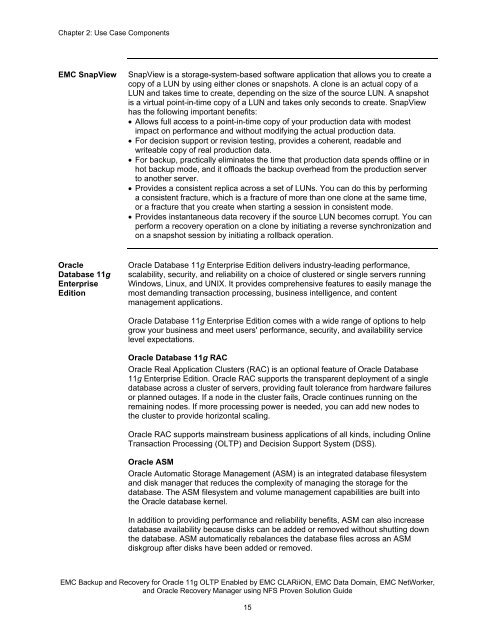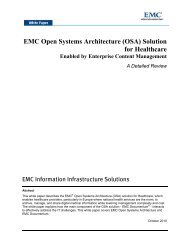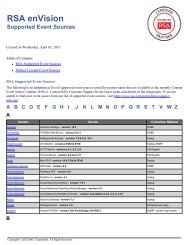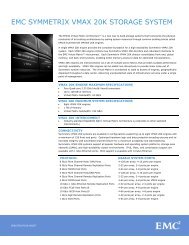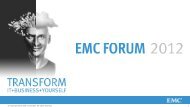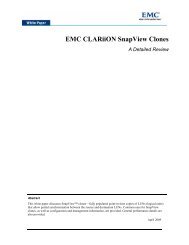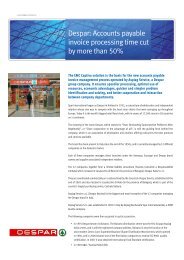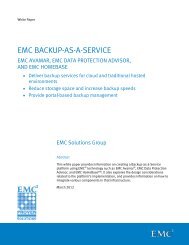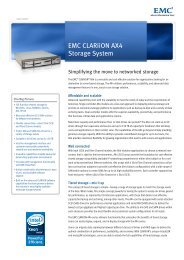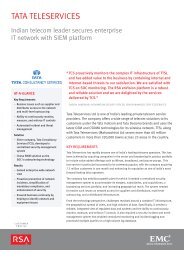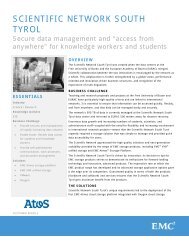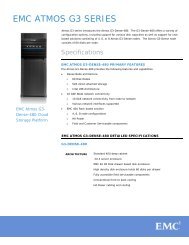EMC Backup and Recovery for Oracle 11g OLTP Enabled by EMC ...
EMC Backup and Recovery for Oracle 11g OLTP Enabled by EMC ...
EMC Backup and Recovery for Oracle 11g OLTP Enabled by EMC ...
Create successful ePaper yourself
Turn your PDF publications into a flip-book with our unique Google optimized e-Paper software.
Chapter 2: Use Case Components<br />
<strong>EMC</strong> SnapView SnapView is a storage-system-based software application that allows you to create a<br />
copy of a LUN <strong>by</strong> using either clones or snapshots. A clone is an actual copy of a<br />
LUN <strong>and</strong> takes time to create, depending on the size of the source LUN. A snapshot<br />
is a virtual point-in-time copy of a LUN <strong>and</strong> takes only seconds to create. SnapView<br />
has the following important benefits:<br />
• Allows full access to a point-in-time copy of your production data with modest<br />
impact on per<strong>for</strong>mance <strong>and</strong> without modifying the actual production data.<br />
• For decision support or revision testing, provides a coherent, readable <strong>and</strong><br />
writeable copy of real production data.<br />
• For backup, practically eliminates the time that production data spends offline or in<br />
hot backup mode, <strong>and</strong> it offloads the backup overhead from the production server<br />
to another server.<br />
• Provides a consistent replica across a set of LUNs. You can do this <strong>by</strong> per<strong>for</strong>ming<br />
a consistent fracture, which is a fracture of more than one clone at the same time,<br />
or a fracture that you create when starting a session in consistent mode.<br />
• Provides instantaneous data recovery if the source LUN becomes corrupt. You can<br />
per<strong>for</strong>m a recovery operation on a clone <strong>by</strong> initiating a reverse synchronization <strong>and</strong><br />
on a snapshot session <strong>by</strong> initiating a rollback operation.<br />
<strong>Oracle</strong><br />
Database <strong>11g</strong><br />
Enterprise<br />
Edition<br />
<strong>Oracle</strong> Database <strong>11g</strong> Enterprise Edition delivers industry-leading per<strong>for</strong>mance,<br />
scalability, security, <strong>and</strong> reliability on a choice of clustered or single servers running<br />
Windows, Linux, <strong>and</strong> UNIX. It provides comprehensive features to easily manage the<br />
most dem<strong>and</strong>ing transaction processing, business intelligence, <strong>and</strong> content<br />
management applications.<br />
<strong>Oracle</strong> Database <strong>11g</strong> Enterprise Edition comes with a wide range of options to help<br />
grow your business <strong>and</strong> meet users' per<strong>for</strong>mance, security, <strong>and</strong> availability service<br />
level expectations.<br />
<strong>Oracle</strong> Database <strong>11g</strong> RAC<br />
<strong>Oracle</strong> Real Application Clusters (RAC) is an optional feature of <strong>Oracle</strong> Database<br />
<strong>11g</strong> Enterprise Edition. <strong>Oracle</strong> RAC supports the transparent deployment of a single<br />
database across a cluster of servers, providing fault tolerance from hardware failures<br />
or planned outages. If a node in the cluster fails, <strong>Oracle</strong> continues running on the<br />
remaining nodes. If more processing power is needed, you can add new nodes to<br />
the cluster to provide horizontal scaling.<br />
<strong>Oracle</strong> RAC supports mainstream business applications of all kinds, including Online<br />
Transaction Processing (<strong>OLTP</strong>) <strong>and</strong> Decision Support System (DSS).<br />
<strong>Oracle</strong> ASM<br />
<strong>Oracle</strong> Automatic Storage Management (ASM) is an integrated database filesystem<br />
<strong>and</strong> disk manager that reduces the complexity of managing the storage <strong>for</strong> the<br />
database. The ASM filesystem <strong>and</strong> volume management capabilities are built into<br />
the <strong>Oracle</strong> database kernel.<br />
In addition to providing per<strong>for</strong>mance <strong>and</strong> reliability benefits, ASM can also increase<br />
database availability because disks can be added or removed without shutting down<br />
the database. ASM automatically rebalances the database files across an ASM<br />
diskgroup after disks have been added or removed.<br />
<strong>EMC</strong> <strong>Backup</strong> <strong>and</strong> <strong>Recovery</strong> <strong>for</strong> <strong>Oracle</strong> <strong>11g</strong> <strong>OLTP</strong> <strong>Enabled</strong> <strong>by</strong> <strong>EMC</strong> CLARiiON, <strong>EMC</strong> Data Domain, <strong>EMC</strong> NetWorker,<br />
<strong>and</strong> <strong>Oracle</strong> <strong>Recovery</strong> Manager using NFS Proven Solution Guide<br />
15


